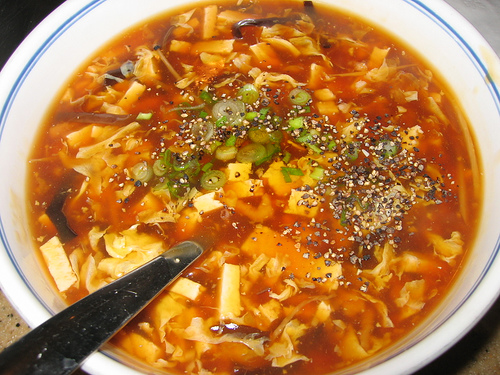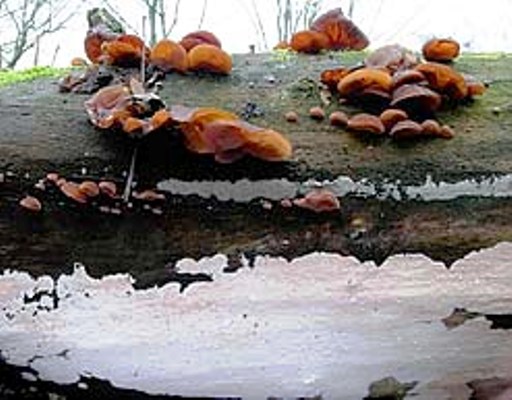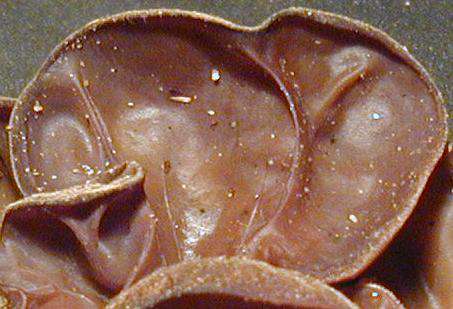Facts
How about we explore some facts about this fungus and perhaps some taste (or the lack there-of to be more accurate.)
©Angelos Papadimitriou from alphagamma.150m.com
First off, the origin for its name "the ear of Judas," came to be due to the fact that the Auricularia auricula-judae commonly grow on the elder tree.
Why does that matter? According to Biblical stories of the days when Jesus roamed the land, Judas, who was one of his apostles, betrayed Him for 30 pieces of silver (Paassen, 2010.) Furthermore, as a result of Judas' guilt, he hung himself on an elder tree. Therefore, this fungus received its present name.
What's more interesting is that because of it being called Jew's ear and Judas' ear, it was at regarded as being anti-Semitist. (Rose, 2005) These mushrooms were used in Nazi propaganda against the Jewish and were seen as "evil" mushrooms due to these misinterpretations. Around the middle ages, this mushroom held bad connotations due to the belief that Jewish were unclean and responsible for the betrayal of Jesus. Because it was said to linked to the demise of Judas, the Auricularia auricula-judae was linked to being "harmful." However, it is far from it.
To continue, this fungus is one of the known fungi that is able to develop in and withstand in freezing temperatures (Paassen, 2010.) It can freeze solidly and thaw out, and still it would not have any problems. This is very useful since it is able to grow most time especially during the coldest month of the year, January.
In Europe, back in the 1800s, there was a theory that people related fungi and plants to a part of the body. If that plant or fungus resembled a specific part of the body, they used it to treat any problem or disease with that correlating plant of fungus. Since the jelly ear fungus was gelatinous resembling the texture of the eye, it was used for eye conditions. Also, it was used to treat any issues with the throat since the structure resembled the throat (Paassen, 2010.)
But wait! There's more! This mushroom is mostly seen as a part of Chinese cuisine as well as in other parts of Asia. It is not very popular in the west.. yet. So here I have added a recipe of a popular soup made with this mushroom for your enjoyment. Although the wood ear fungi are nearly flavorless, they are very good at absorbing the flavors of the ingredients it is cooked with (Milne, 2009)
Hot and Sour Soup Recipe
Ingredients:
6 dried Chinese black fungus
6 dried wood ear, black, cloud, straw, or shiitake mushrooms, or one bunch of fresh enoki mushrooms
5 dried lily buds One can of bamboo shoots
2 tablespoons of red wine vinegar
1 tablespoon of white vinegar or rice vinegar
1 1/2 tablespoons of soy sauce
1 tablespoon of cornstarch
4 cups of chicken broth (use gluten-free broth for gluten-free version)
1/2 block of firm tofu, diced into small cubes
1 egg, beaten
1 teaspoon of sesame oil
3 scallions, diced
1/4 teaspoon of salt
1 1/2 teaspoons of finely ground white pepper
1/4 teaspoon of chili oil (optional) Cilantro (optional)
Method:
1. Pour boiling water over the mushrooms until the mushrooms are covered and allow them to soak for 20 minutes, turning the mushrooms over occasionally. It may not seem like a lot but they will grow quite a bit. After soaking remove any woody ends with a knife. Cut mushrooms into strips. Reserve 1/4 cup of the liquid and mix with the cornstarch. (If using fresh enoki mushrooms set aside as they do not need to soak).
2. Pour boiling water over the lily buds until covered and allow to sit for 15 minutes. Cut the buds crosswise then tear them up into a few bunches.
3. Mix the vinegars and soy sauce together and set aside. Open the can of bamboo shoots, drain well, and cut the shoots lengthwise into strips.
4. Place the chicken broth into a bot and bring to a boil over high heat. Add the tofu, mushrooms, lily buds, bamboo shoots, vinegar mixture, and cornstarch mixture. Mix and bring back to a boil. Once it comes to a boil remove from heat. While stirring the soup slowly pour the egg into the broth in a small steam while stirring the soup allowing the egg to instantly cook and feather into the soup.
5. Add the scallions, white pepper, sesame oil, and chili oil if using. Taste and adjust white pepper, vinegar, and salt to taste. Add cilantro to garnish and for added flavor.
Serve immediately. Serves 4.
© Flirck.com under creative commons license
 Now
doesn't this look delicious. I know the ingredients are hard to come by, but
I do think it is worth it.
Now
doesn't this look delicious. I know the ingredients are hard to come by, but
I do think it is worth it.
I hope you enjoyed reading about the facts of this peculiar fungus.
If you would like to view where I obtained all of my research information head on over to the references section of the webpage.
Also, Feel free to watch this video that explains the features of this fungus and also shows a dish that was prepared by the creator of the video. Enjoy!
Go Home.
 Auricularia
auricula-judae
Auricularia
auricula-judae 